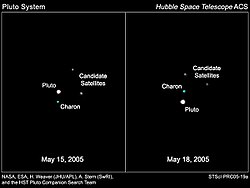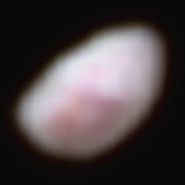Template:Infobox planet
Nix is a natural satellite of Pluto. It was discovered along with Hydra (Pluto's outermost satellite) in June 2005. It was imaged along with Pluto and its other moons by the New Horizons spacecraft as it flew by the Pluto system in July 2015.[1] Of the four small Plutonian moons the best pictures are of Nix, with resolutions as high as 330 meters per pixel.[2]
History[]
Discovery[]

Discovery images of Nix (and Hydra)
Nix was found by the Hubble Space Telescope Pluto Companion Search Team, composed of Hal A. Weaver, Alan Stern, Max J. Mutchler, Andrew J. Steffl, Marc W. Buie, William J. Merline, John R. Spencer, Eliot F. Young, and Leslie A. Young. The discovery images were taken on 15 May 2005 and 18 May 2005. Nix and Hydra were independently discovered by Max J. Mutchler on 15 June 2005 and by Andrew J. Steffl on 15 August 2005. The discoveries were announced on 31 October 2005, after confirmation by precoveries from 2002. They were provisionally designated S/2005 P 1 (Hydra) and S/2005 P 2 (Nix) and casually referred to as "P1" and "P2", respectively.[3][4]
Name[]
The formal name "Nix", from the Greek goddess of darkness and night and mother of Charon (ferryman of Hades), was announced on 21 June 2006 on IAU Circular 8723,[3] where the designation Pluto II is also given. The initials N and H, for Nix and Hydra, come from "New Horizons". The original proposal was to use the classical spelling Nyx, but to avoid confusion with the asteroid 3908 Nyx, the spelling was changed to Nix. Jürgen Blunck explains it as the "Spanish translation" of the Greek name.[5]
Orbit and rotation[]
Nix follows a circular orbit in the same plane as Charon.[6] It is in a 3:2 orbital resonance with Hydra, and a 9:11 resonance with Styx (the ratios represent numbers of orbits completed per unit time; the period ratios are the inverses).[7][8] As a result of this "Laplace-like" 3-body resonance, it has conjunctions with Styx and Hydra in a 2:3 ratio.
Its orbital period of 24.9 days is also close to a 1:4 orbital resonance with Charon, but the timing discrepancy is 2.8%; there is no active resonance.[7][9] A hypothesis explaining such a near-resonance is that it originated before the outward migration of Charon following the formation of all five known moons, and is maintained by the periodic local fluctuation of 9% in the Pluto–Charon gravitational field strength.
As with Hydra and perhaps the other small Plutonian moons, Nix tumbles chaotically; the moon's axial tilt and day length vary greatly over short timescales.[10][11] At the time of New Horizon's flyby, Nix was rotating with a period of 43.9 hours retrograde to Pluto's equator with an inclination of 132 degrees — in other words it is rotating "backwards" in relation to its orbit around Pluto.[12] The rotation period has actually increased by 10% since Nix was discovered.[12]
Physical characteristics[]
Nix has been measured to be Template loop detected: Template:Convert/x in diameter, indicating a very elongated shape, and a very high geometric albedo.[6] In the discovery image, Nix is 6,300 times fainter than Pluto.[13] New Horizons determined that Nix is approximately Template:Convert/round kilometers (20 mi) across.[14]
Early research appeared to show that Nix was reddish like Pluto and unlike the other moons,[9] but more-recent reports have been that it is grey like the remaining satellites.[15] New Horizons spotted a large region with a distinctive red tint surrounding a large crater, which may explain these conflicting results.[16] Detailed images of the moon have revealed at least 6 impact craters on it, the largest of which is about 15 km across.
Exploration[]
New Horizons is the only spacecraft that has flown through the Pluto system and hence the only one that has explored Nix. Until 13 July 2015, when NASA's Long Range Reconnaissance Imager on board New Horizons determined Nix's size,[14] all but its existence was unknown. Of Pluto's smaller satellites, it was the only one clearly imaged.
References[]
- ↑ Cain, Fraser (2008). "Pluto’s Moon Nix". http://www.universetoday.com/13905/plutos-moon-nix/.
- ↑ New Horizons flyby timeline
- ↑ 3.0 3.1 IAU Circular No. 8723 naming the moons
- ↑ IAU Circular No. 8625 describing the discovery
- ↑ Blunck, Jürgen, Solar System Moons: Discovery and Mythology (2009), p. 129.
- ↑ 6.0 6.1 Cite error: Invalid
<ref>tag; no text was provided for refs namedscimag000 - ↑ 7.0 7.1 Cite error: Invalid
<ref>tag; no text was provided for refs namedShowalterHamilton2015 - ↑ Template:Cite journal
- ↑ 9.0 9.1 Cite error: Invalid
<ref>tag; no text was provided for refs namedBuie_2006 - ↑ Boyle, Alan. "Pluto's Moons Raise New Puzzles for NASA's New Horizons Mission". NBC News. http://www.nbcnews.com/science/space/plutos-moons-raise-new-puzzles-nasas-new-horizons-mission-n368741. Retrieved 3 June 2015.
- ↑ Northon, Karen. "NASA’s Hubble Finds Pluto’s Moons Tumbling in Absolute Chaos". https://www.nasa.gov/press-release/nasa-s-hubble-finds-pluto-s-moons-tumbling-in-absolute-chaos. Retrieved 2015-10-25.
- ↑ 12.0 12.1 Lakdawalla, Emily. "DPS 2015: Pluto's small moons Styx, Nix, Kerberos, and Hydra". Archived from the original on 14 November 2015. http://www.planetary.org/blogs/emily-lakdawalla/2015/dps15-1110-small-moons.html. Retrieved 14 November 2015.
- ↑ Brightness Difference on 2005-05-15: (5th root of 100) ^ (Nix APmag 23.38 – Pluto APmag 13.87) = 6,368x
- ↑ 14.0 14.1 "How Big Is Pluto? New Horizons Settles Decades-Long Debate". NASA. 13 July 2015. http://www.nasa.gov/feature/how-big-is-pluto-new-horizons-settles-decades-long-debate/.
- ↑ Template:Cite journal (Preprint, as submitted; final preprint.)
- ↑ New Horizons Captures Two of Pluto's Smaller Moons NASA, 21 July 2015
- Template:Cite journal(Final preprint)
External links[]
| File:Commons-Logo.svg | Wikimedia Commons has media related to Category:Nix. |
- Nix Profile by NASA's Solar System Exploration
- Background Information Regarding Our Two Newly Discovered Satellites of Pluto – The discoverers' website
- NASA's Hubble Reveals Possible New Moons Around Pluto – Hubble press release
- Two More Moons Discovered Orbiting Pluto (SPACE.com)
- Pluto's Newest Moons Named Hydra and Nix (SPACE.com)
| ||||||||||||||||||||||||||||||||||||||||||||||||||||||||||||||||||||||||||
Template:Moons of dwarf planets Template:Trans-Neptunian objects
| This page uses Creative Commons Licensed content from Wikipedia (view authors). | 
|






